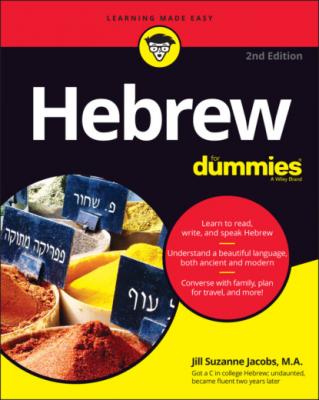Hebrew For Dummies. Jill Suzanne Jacobs
Чтение книги онлайн.
Читать онлайн книгу Hebrew For Dummies - Jill Suzanne Jacobs страница 16

Those dots and dashes they call vowels
Originally, Hebrew had no vowels. Vowels, in the form of dots and lines below the consonants, were added to Hebrew writing in the seventh century CE. Before then, people read without vowels. Even today, most books, magazines, and newspapers in Modern Hebrew — not to mention the Torah scroll — are written without vowels.
Modern Hebrew has both long and short vowels. As a general rule, a long vowel can make up one syllable, but a short vowel needs either another vowel or a שָׁוְא (shuh-vah; two vertical dots below a consonant) to form a syllable. For more on the שָׁוְא, see “Introducing the Shvah” later in this chapter.
As I mentioned earlier, vowels are divided into long and short vowels. This categorization doesn’t have to do with their pronunciation but with the fact that long vowels are usually in open syllables — syllables that end with a vowel — and short vowels are usually in closed syllables — syllables that end with a consonant. The long vowel חִירִיק מָלֵא (Chirik Maleh), however, holds its sound longer than the corresponding short vowel חָרִיק חַסֵּר (hirek haser). Table 1-6 shows the long vowels.
TABLE 1-6 The Long Vowels
| Name of the Vowel | Pronunciation | In Hebrew | The Sound It Makes |
|---|---|---|---|
| Hirik Maleh | ḥee-reek mah-leh | iאִי | Makes an Ee sound as in see |
| Holam | ḥoh-lahm | אֹ | Makes an O sound as in more |
| Kamatz Gadol | kah-mahtz | אָ | Makes an Ah sound as in saw |
| Shuruk | shoo-rook | אוּ | Makes an Oo sound as in mood |
| Tzere | tzay-reh | אֵ | Makes an A sound as in cape |
| Vav Cholam | vahv ḥoh-lahm | אוֹ | Makes an O sound as in snow |
Note: In this table, I used the letter א (aleph) so you could see how the vowels look when they’re attached to a consanant. (The vowels are the little squiggles and dots around the א.) Unlike in English, Hebrew vowels can never be written alone; they’re always attached to a consonant.
Table 1-7 shows the short vowels.
TABLE 1-7 The Short Vowels
| Name of the Vowel | Pronunciation | In Hebrew | The Sound It Makes |
|---|---|---|---|
| Herik Haser | ḥee-reekḥah-sehr | אִ | Makes an Ee sound as in see |
| Kamatz Katan | kah-mahtz kah-tahn | אׇ | Makes an O sound as in more |
| Kubutz | koo-bootz | אֻ | Makes an Oo sound as in mood |
| Patach | pah-tahḥ | אַ | Makes an Ah sound as in saw |
| Segol | seh-gohl | אֶ | Makes an Eh sound as in end |
Note: In this table, I used the letter א (aleph) so you could see how the vowels look when they’re attached to a consanant. (The vowels are the little squiggles and dots around the א.)
Sometimes, the Kamatz Patah, Kamatz Katan, or the Segol is paired with a Shvah. This pairing doesn’t change the pronunciation.
Introducing the Shvah
Shvah Na (shvah nah), which opens a syllable
Shvah Nach (shvah nahḥ), which closes a syllable
Shvah Merahef (shvah mehr-rah-ḥehf ), known as the flying shvah, which results from two Shvah Nas being next to each other in a word
The Shvahs don’t make their own sound but are essentially placeholders for the consonant above